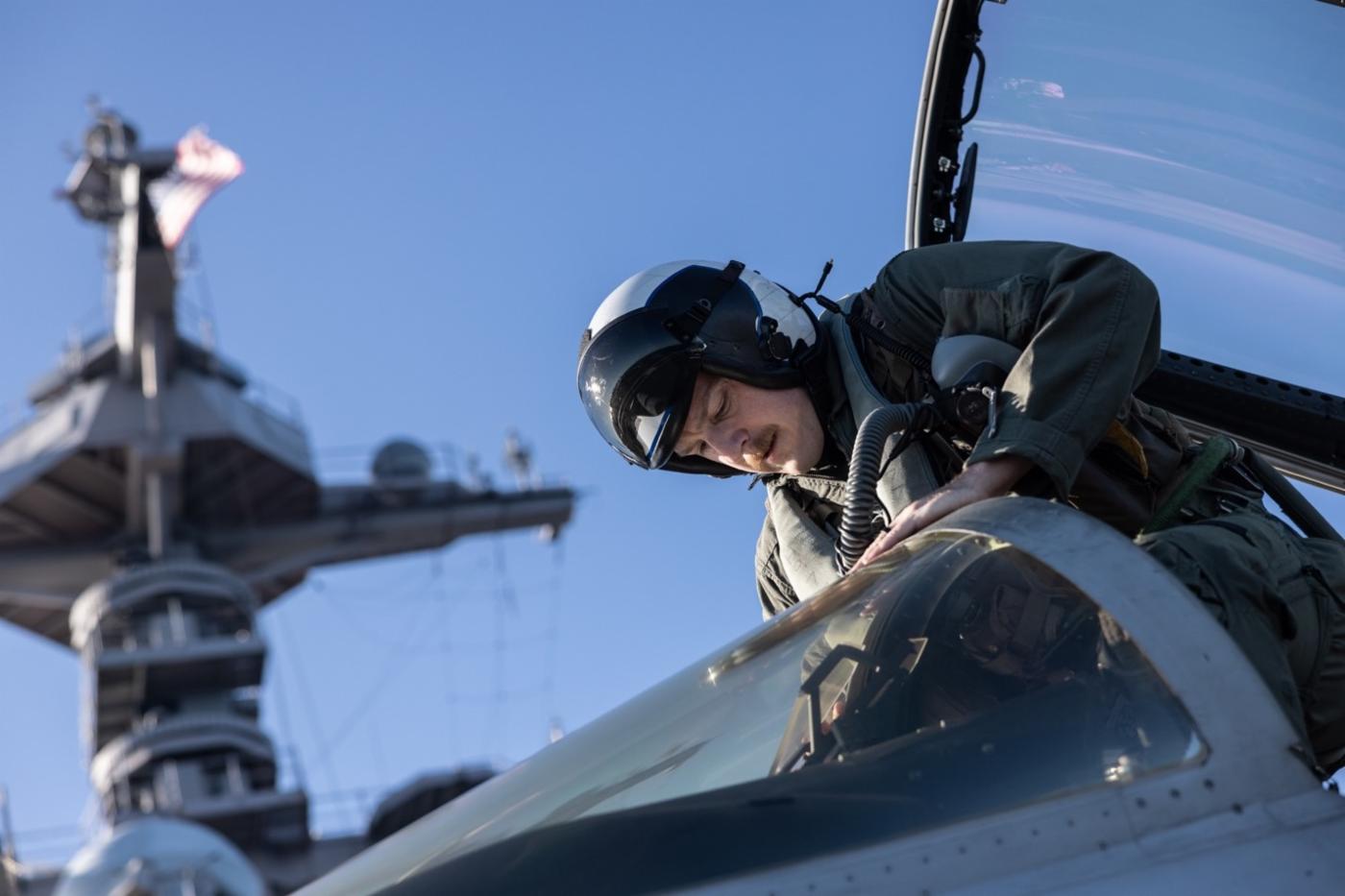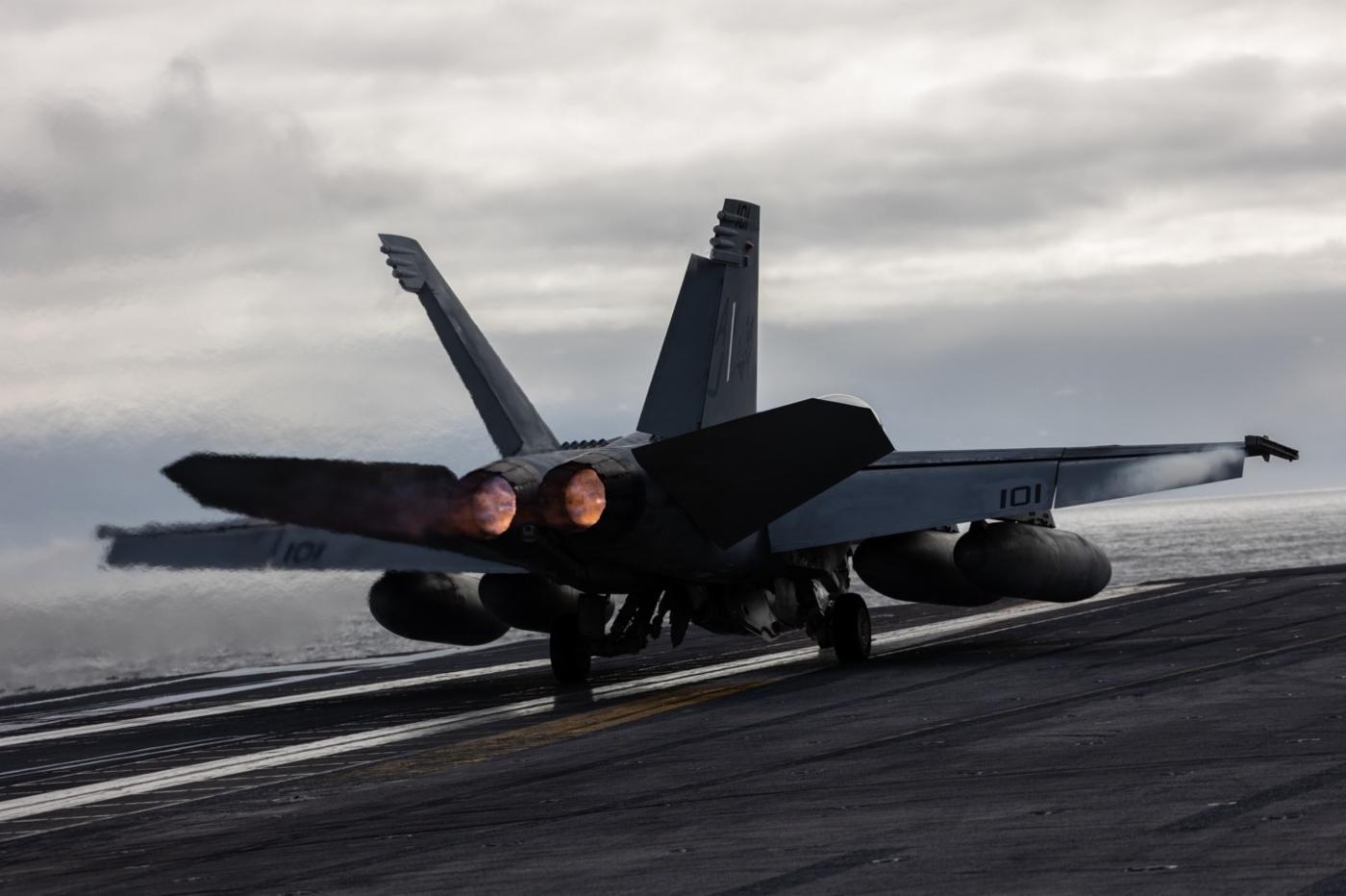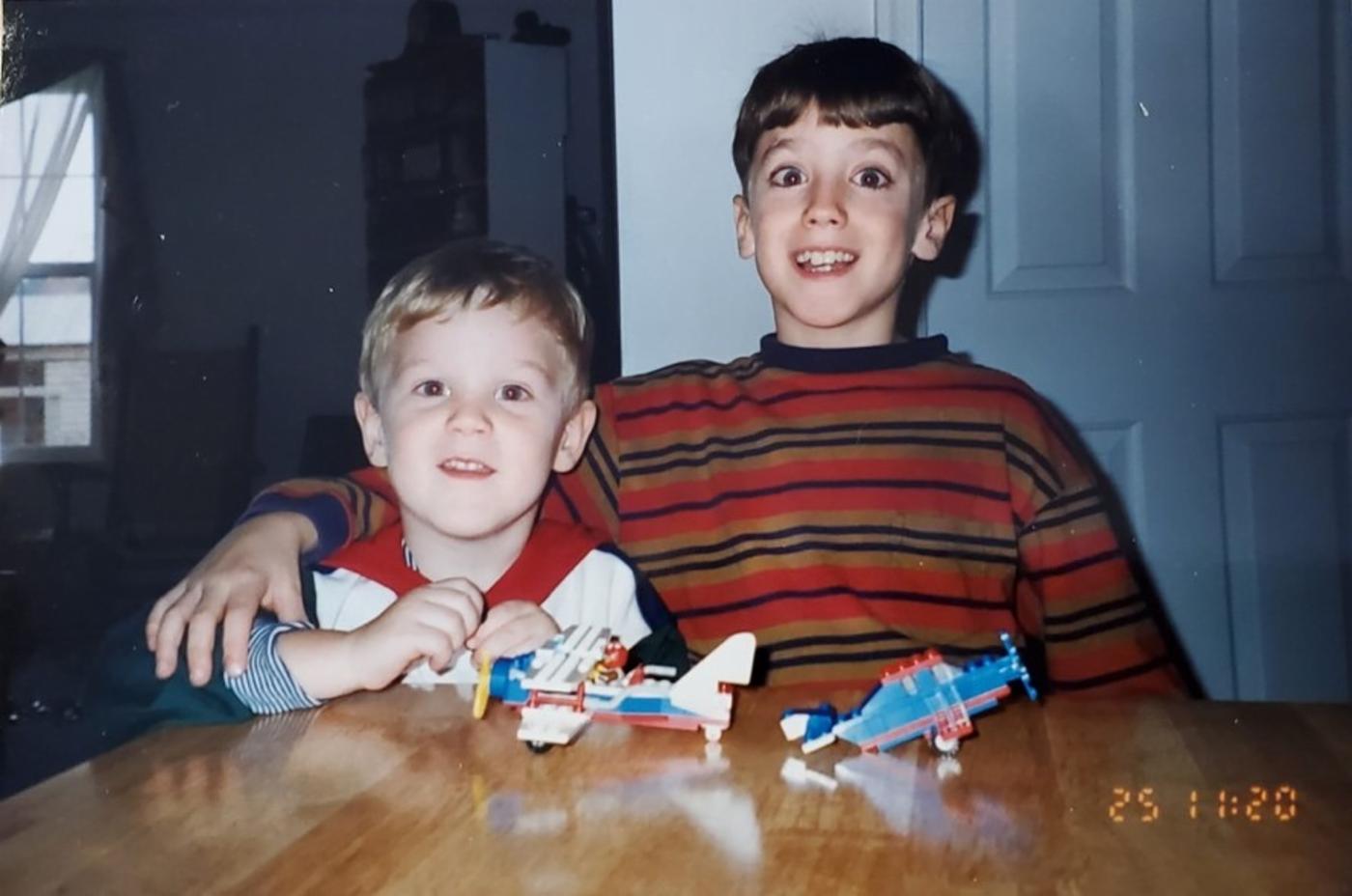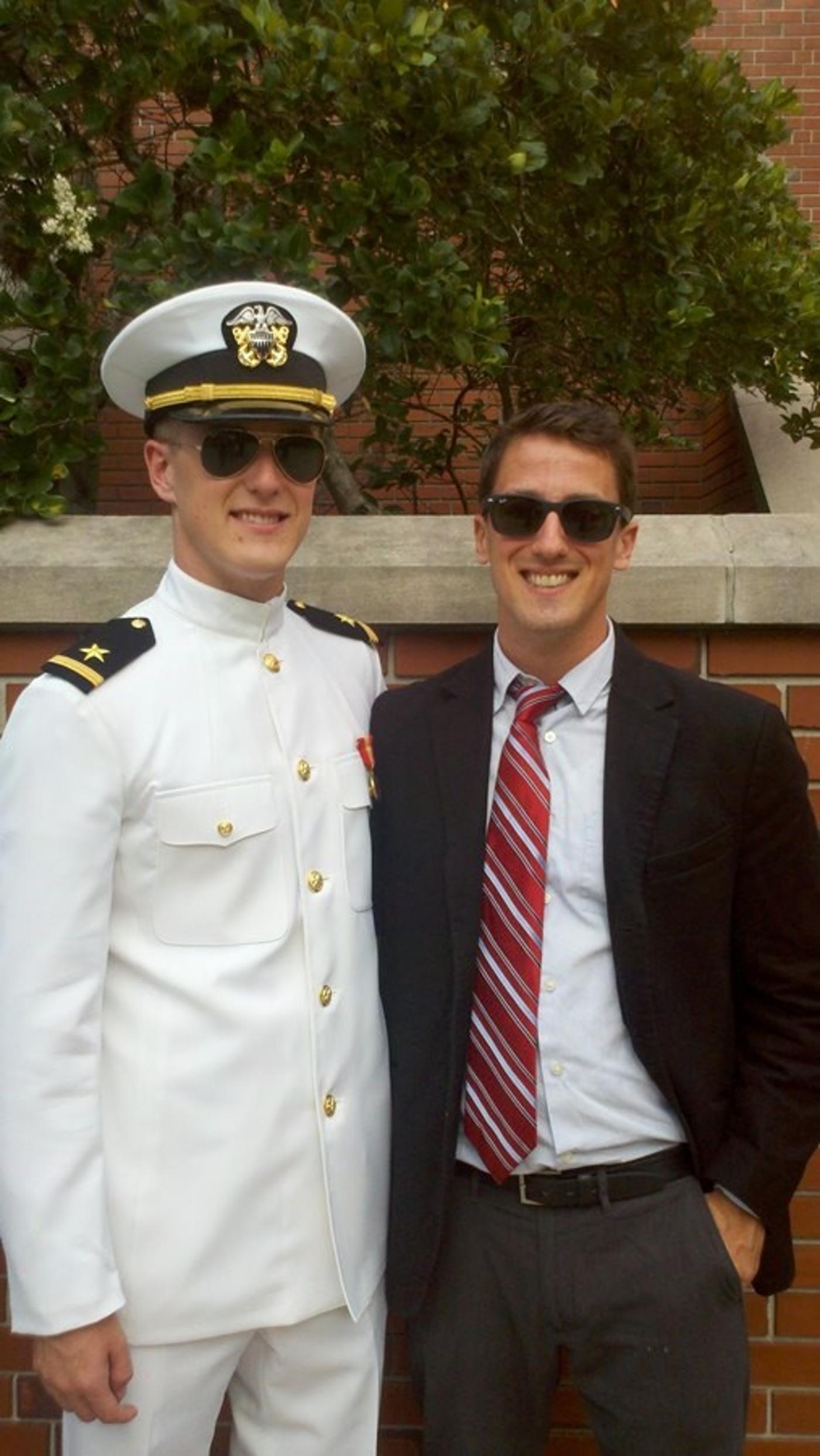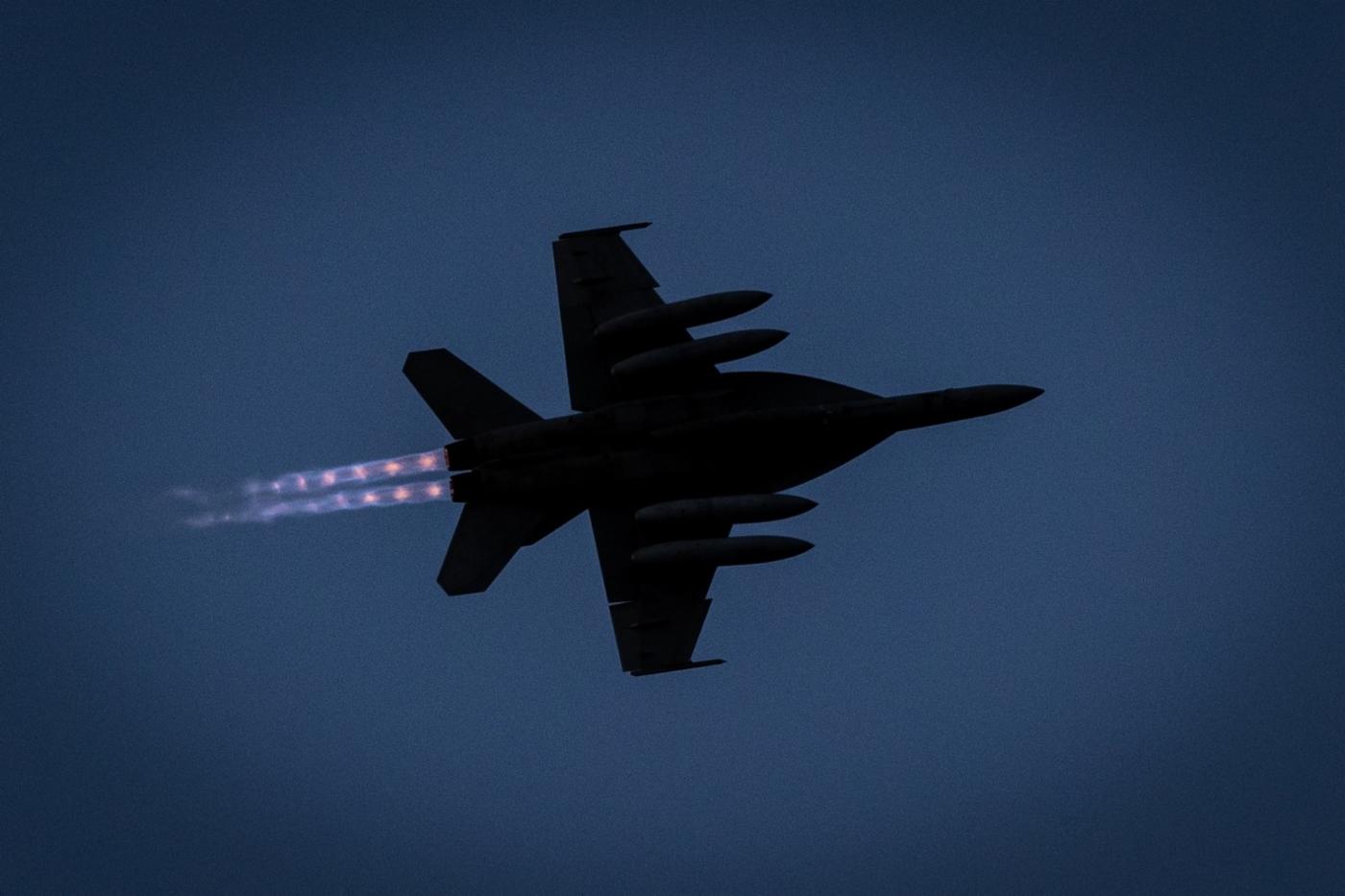The USS Gerald R. Ford – the US Navy’s newest supercarrier, and the largest and most technologically advanced aircraft carrier in the world – recently crossed the Atlantic alongside warships from other NATO Allies. Aboard ship, two brothers mark the Ford’s first deployment – and one brother’s final flight.
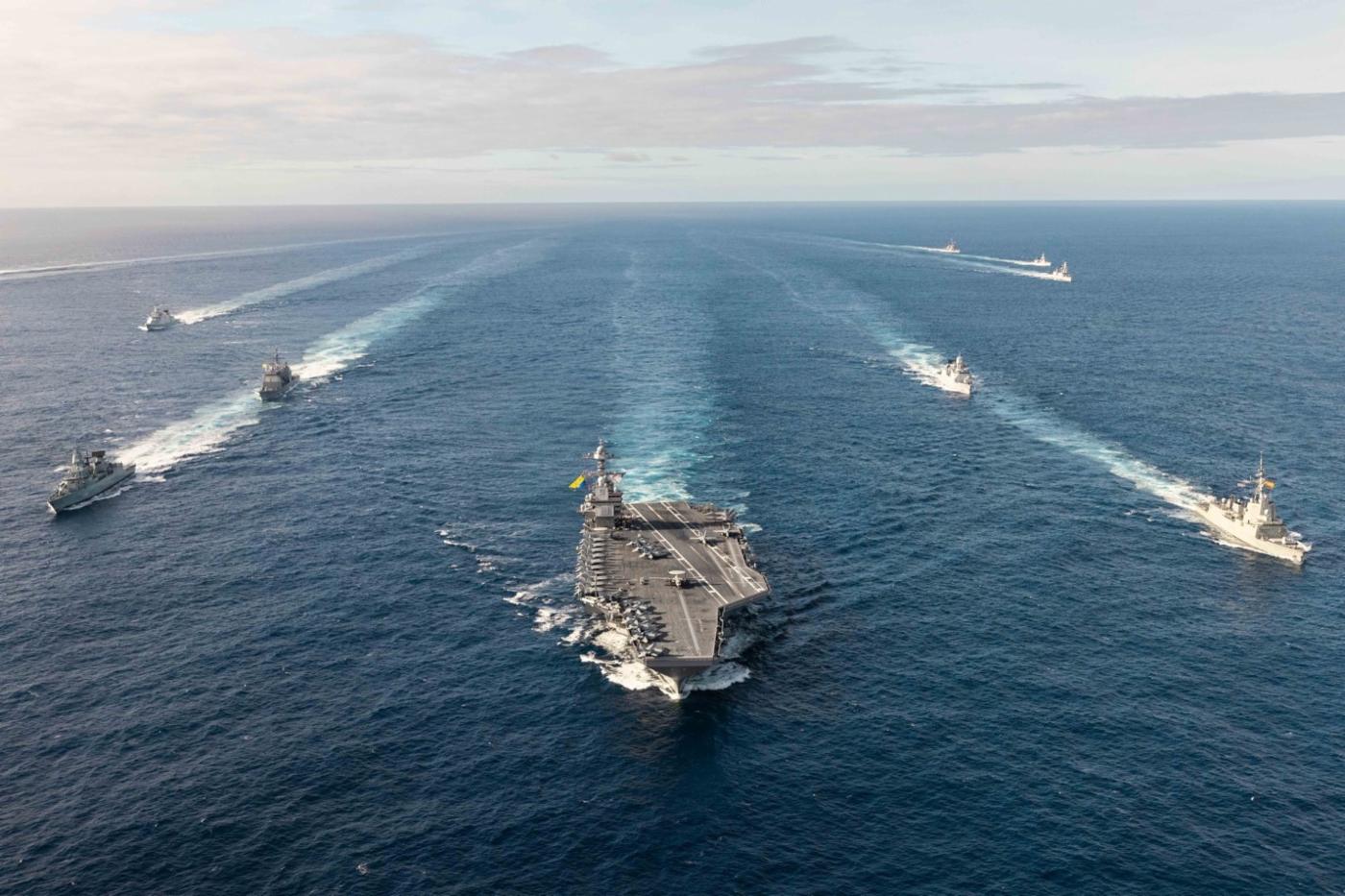
The USS Gerald R. Ford leads a carrier strike group across the Atlantic Ocean, demonstrating the enduring bond
between NATO Allies in Europe and North America.
The fighter pilot makes his way through the depths of the ship, shouldering past sailors in the dim, narrow corridors. When he reaches the deck, he lifts the heavy latch on a door and pushes it open. Beyond, the Atlantic Ocean is a flat sheet of gunmetal grey, dappled with rushing whitecaps. The smells of metal and fresh paint give way to crisp gusts of sea air – and the acrid tang of jet fumes.
Finding his F/A-18E Super Hornet strike fighter parked on the deck, the pilot fist-bumps the enlisted aircraft maintainers and circles the jet, peering into open panels, giving the fuel tanks slung under the wings a good nudge to make sure they’re secure. When he’s satisfied, he salutes the crew and climbs a ladder into the cockpit. To his right, the flight control tower and radar masts of the USS Gerald R. Ford loom imposingly.
It’s a good picture. I raise my camera and squeeze off a burst. The pilot looks at me, his mouth a tight, tolerant line: you done yet?
This is Lieutenant Commander Phillip Kunzig – naval officer, aviator and my brother.
I’ve been with him for two weeks aboard the ship as it makes its way from Halifax, Canada to the shores of Portugal, escorted by ships from six other NATO Allies – Canada, Denmark, France, Germany, the Netherlands and Spain – as part of the multinational exercise Silent Wolverine. As a video producer for NATO, I’m here to document the voyage. My job is to film the aircraft launches and recoveries, the green-shirted maintainers crawling over jets in the hangar deck, and the busy passageways of the world’s largest warship.
For the Ford, the journey feels like an initiation into the NATO family. The Carrier Strike Group will retrace the route taken by Canadian and US merchant ships 80 years prior, when they ferried troops and supplies to Europe during World War II. That aid was decisive for Allied forces liberating Europe and it formed the transatlantic foundation upon which NATO was built a few years later.
But for me, it feels like the end of an era.
From a catwalk above the flight deck, I watch Phil nudge the jet from its parking spot and pull up to one of the Ford’s four jet catapults. A jet blast deflector rises behind his engines and deck sailors scurry around the Hornet, readying it for take-off.
It’s something he’s done a hundred times before – and something he’ll do now for the last time. This will be his final carrier take-off and landing. In a few months, he will leave the US Navy, concluding a journey that began more than 14 years ago.
He pushes the throttle to full power. The engines flare and roar. He gives the deck sailors a curt salute and grabs onto the handle, ready for the kick, the rush of acceleration, and the sudden appearance of water beneath his wings.
A city at sea – the USS Gerald R. Ford
You can’t really appreciate the size of an aircraft carrier until you see a human being standing on one.
As the ferry rounds the stern of the 330-metre, 100,000-ton warship in Halifax harbour, the blue-jacketed sailors standing on the boarding dock look miniscule next to the hulking grey hull.
Over the next two weeks, this floating behemoth will be our home.
Day and night, the ship buzzes with activity. In the cavernous hangar bay – probably the single largest room on the Atlantic – green-shirted mechanics crawl over their aircraft like ants, peering into the engines with flashlights and twisting speed wrenches. The galleys churn out food nonstop, serving three meals a day plus midnight rations (“midrats,” a reheat of the day’s leftovers much beloved by tired watch-standers and insomniac pilots).
While sailors eat, sleep and work aboard the USS Gerald R. Ford, two nuclear reactors thrum deep inside the ship, turning the screws that propel the ship and keeping the lights on. Their 600-megawatt combined output is three times the power plant on the Nimitz-class carrier the Ford is intended to replace and enough to power a small city. Which the Ford is, actually. Even though the ship’s advanced systems require fewer sailors to crew them, there are still more than 4,000 souls aboard. When they aren’t working, they indulge in small pleasures: a fresh haircut from the ship’s barber shop. A cup of Starbucks from the ship’s coffee shop. A workout on the hangar deck, where the open doors give them a view of the cold and foggy Atlantic as they lift weights, row or pedal on stationary bikes.
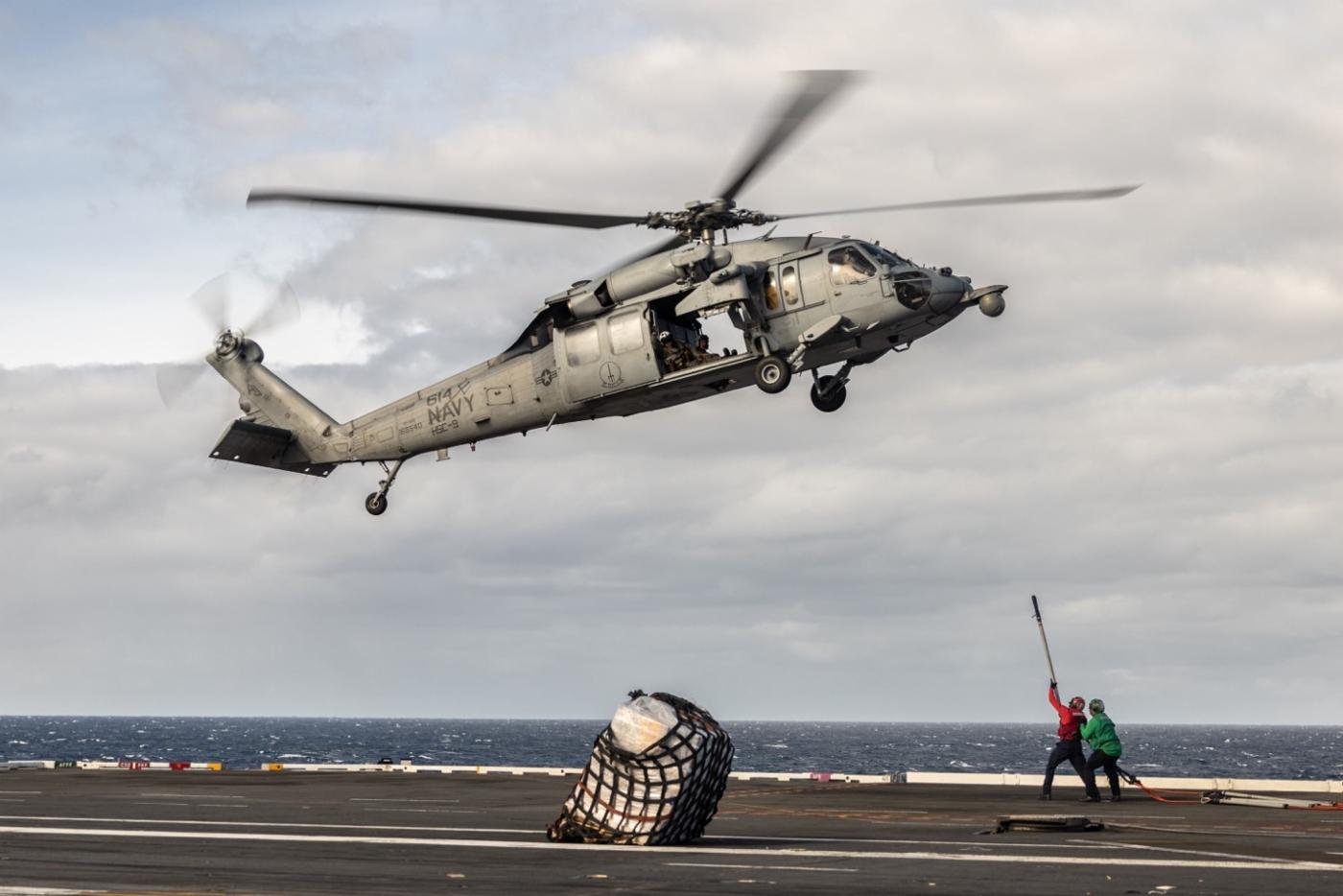
An H-60 Sierra utility helicopter performs a “VertRep” (vertical replenishment), where helicopters yo-yo between the Ford’s flight deck and an adjacent supply ship, slinging crates of supplies beneath them.
A pilot’s life for me
When we first board the sprawling city-at-sea, I follow Phil down the narrow passageways to our five-man stateroom at the bow of the ship, just one level below the flight deck.
“Why’s it so cold?” I ask. The stateroom feels like a meat locker.
“Things smell less when it’s cold,” he says as he shucks his civilian clothes and steps into his flight suit.
It isn’t the first time I’ve seen him in uniform, but the official trappings of his job only remind me of where this fighter pilot got his start: as a mop-headed, bespectacled introvert with little interest in anything beyond naval aviation.
It seems obvious, in retrospect. Top Gun was a holy text of our youth, a super-saturated fever dream of aerial combat. Its flash and glamour were balanced by the black-and-white portrait of our grandfather, Navy Captain Richard Schnorf, opposite the television, his chest adorned with rows of ribbons topped with a pair of aviator’s wings. His career spanned three wars and 32 years. When we saw him, we called him grandfather – not grandpa, not pop-pop.
If only the “best of the best” became naval aviators, Phil seemed at first to be an unlikely candidate. He was a middle-mark student. He didn’t play any sports; instead, he played Xbox. He was a talented musician, but that hardly earmarked him for service. When he told me he was pursuing a scholarship from the Navy Reserve Officer Training Corps, I wished him luck.
When he got it, I was stunned. Was he really doing this? The answer came the following autumn, when he sent a selfie in officer’s khakis, sporting a buzz cut.
To become a fighter pilot is to pass through a series of increasingly narrow sieves, keeping your “cutting score” high while hoping that the Navy didn’t need helicopter pilots instead. For Phil, this meant countless hours studying the F/A-18 Super Hornet’s operating manual, logging time in the flight simulator, trading sleep for knowledge in hopes that he’d fly well enough to impress his instructors.
It took four years in college and two years at the Naval Aviation School in Florida, but in 2014, he grinned in his dress whites as the camera flash caught the gold wings on his left breast – grandfather’s wings, pinned on by our uncle. Three years later, he was flying combat missions against ISIS over Iraq and Syria.
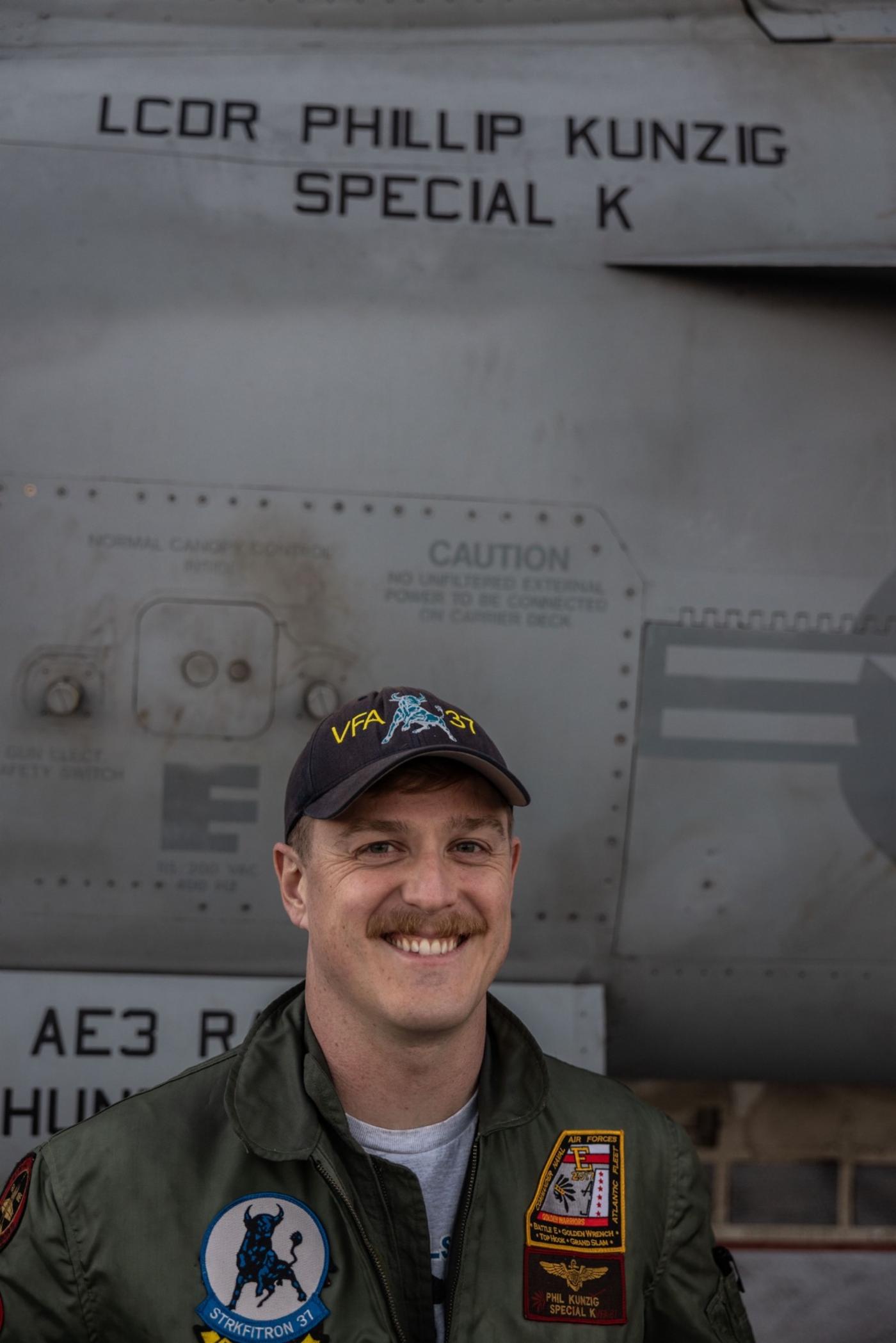
Lieutenant Commander Phillip Kunzig
poses next to his F/A-18E Super Hornet
on the deck of the USS Gerald R. Ford.
It’s been more than four years since that tour. Some of the same jets he flew now share deck space with Super Hornets assigned to his new squadron, Strike Fighter Squadron 37 – the “Raging Bulls.”
I was surprised by his decision to leave the Navy. He’s a skilled pilot. What could possibly measure up to flying fighters off an aircraft carrier? Won’t he miss it?
Sure, he said, but he’d accomplished what he’d set out to do, and new challenges awaited: raising his sons, making a career as a civilian pilot. Onward.
We spot a jet with a familiar name stencilled under the canopy: LCDR PHILLIP KUNZIG. “SPECIAL K.” I make him pose for a picture underneath it. I fiddle with the framing and exposure as the smile grows stale on his face. “Hurry up,” he says.
“Deal with it. This is for mom and dad,” I say.
“Is this what it’s going to be like for the next two weeks?”
“Absolutely.”
Landing without land – the perks of naval aviation
The days grind on. Sailors from the strike group’s escorts come aboard via helicopter to check out the new carrier. One group of Dutch sailors from the frigate HNLMS De Zeven Provincien asks where the enlisted bar is located. They are astonished to learn that there isn’t one; US Navy ships run dry. When they find out the ship doesn’t have a dedicated bakery either, they look disturbed.
One Sunday, the Raging Bulls host a Game of Thrones marathon, complete with popcorn served in coffee filters. But eventually, the Ford passes the Azores, a Portuguese island chain roughly 1,400 kilometres from the Iberian peninsula, and the ship’s captain announces that flight operations will begin the next day.
The mood in the room elevates. The schedules rolling off the printer are full of flights, with times, pilots’ surnames and aircraft load outs beside them.
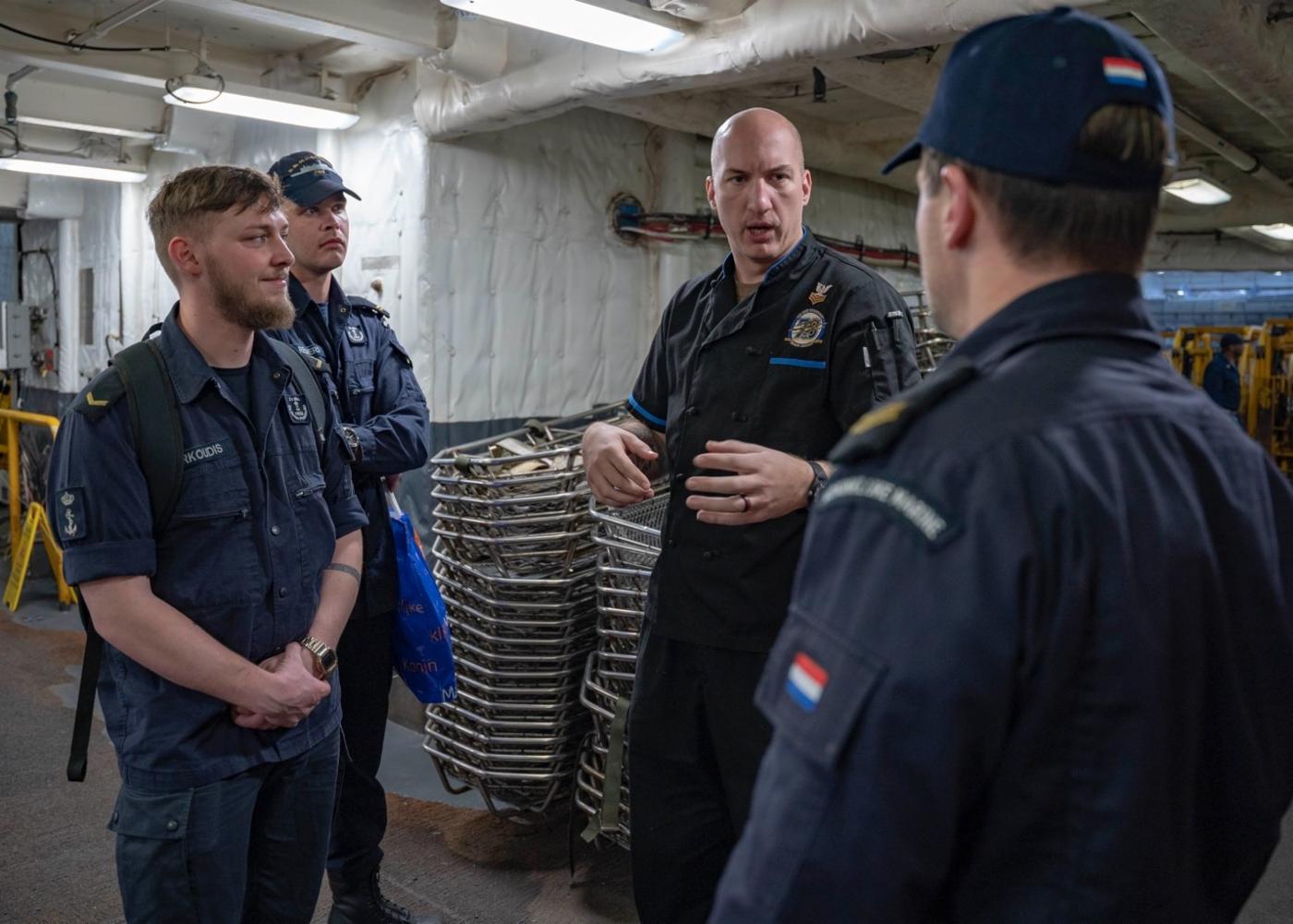
Allied sailors come on board the Ford during transit, including Dutch sailors from the HNLMS De Zeven Provincien.
The next morning, the pilots head to the parachute lofts, where they step into G-Suit pants – olive-drab chaps designed to inflate around their thighs and help keep the blood in their brains during high-speed turns. They shoulder on flight vests and claim their helmets from the rack, rubber air hoses jiggling. From there, it’s a short walk up to the flight deck to find their jets.
At first, the flight deck feels chaotic. Sailors in coloured jerseys wave their arms, point, tap their heads in a sign language totally incomprehensible to the uninitiated. Plane directors manage the flow of traffic, moving jets from their parking positions and onto the catapults. Aircraft crew hook the front gear to the shuttle, a low wedge of steel that will pull the jet down the catapult track. Once a Hornet is in place, a massive panel called a Jet Blast Deflector rises behind it.
The plane director shakes his hands, signalling the pilot to bring the engines to “military power.” Even wearing soundproof earmuffs, the roar is crushing; something felt more than heard.
From a glass bubble built into the deck, the sailor in charge of launching the aircraft – the “shooter” – looks for thumbs-up from the deck sailors surrounding the aircraft. If everything looks good, he or she fires the catapult.
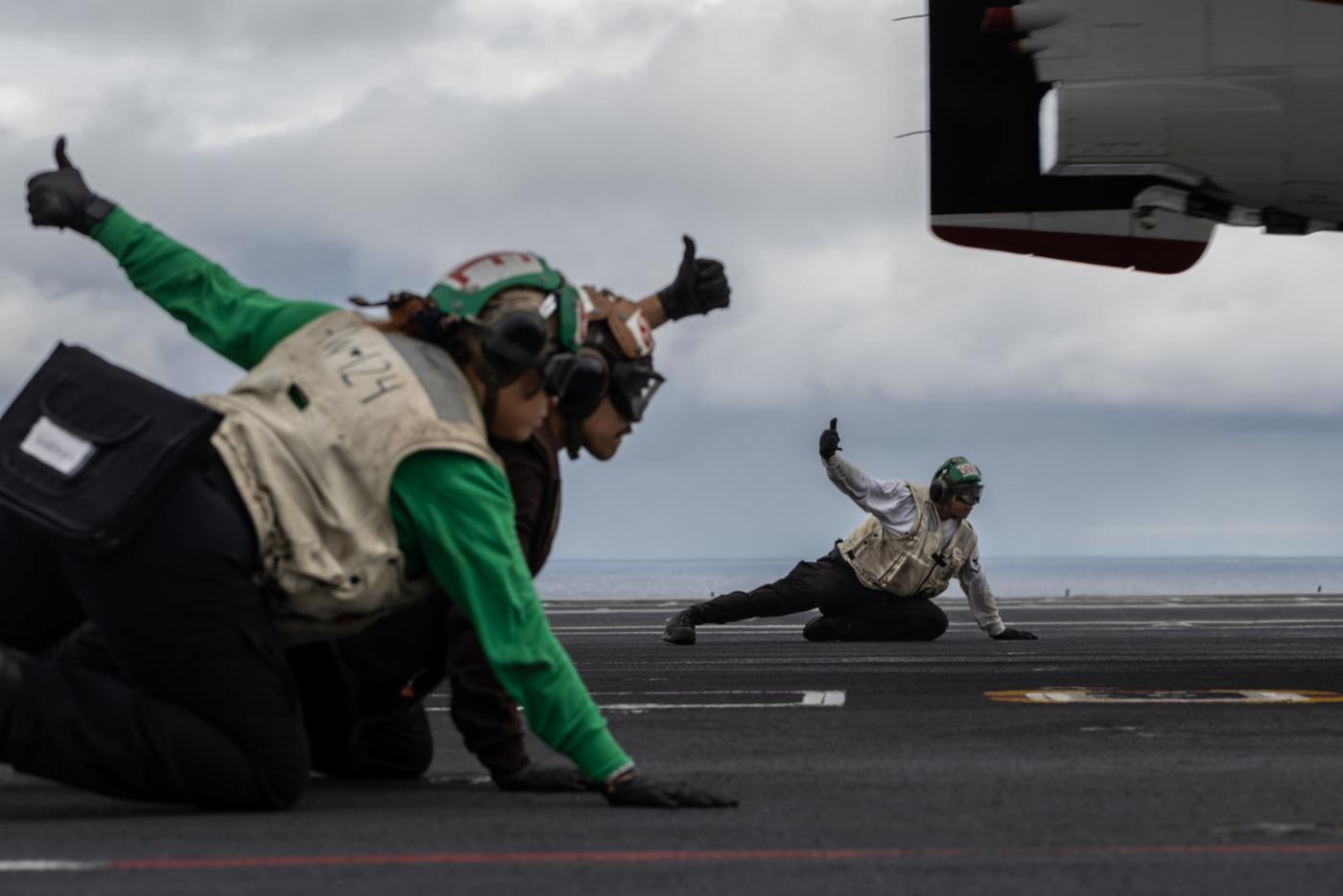
US Navy sailors brace themselves as an E-2D Hawkeye surveillance aircraft takes off from the deck of the USS Gerald R. Ford.
The jet nods slightly as the shuttle yanks it by the nose and pulls it down the 100-metre track towards the edge of the ship, where it slingshots the Hornet into the air. Inside the cockpit, the pilot is thrown against their restraints as the acceleration from the catapult disappears. They turn the jet towards their take-off pattern, raise the gears and await clearance to climb to their cruising altitude.
From there, they perform any one of the Hornet’s many missions. During Silent Wolverine, the Ford’s Hornets will practise interceptions, combat air patrols and anti-ship operations. Some of the missions will be controlled by the Allied ships in the flotilla, giving the strike group a chance to work through the usual language barriers and procedural frictions that come with multinational military operations.
Then comes the true test of a naval aviator: landing.
If the sun is up and the weather is good, the jets will perform a “case one” approach, flying a racetrack loop around the carrier before landing. They break left ahead of the bow, bleeding off speed. On a platform near the ship’s rear, the Landing Signal Officer (LSO) – or “Paddles,” harkening back to the days when LSOs used coloured paddles to guide planes in for landing – is talking into a phone, telling them to add power, lose power, come left, come right.
The pilot uses their rudder pedals and stick to make tiny adjustments, aiming their nose for the deck’s centreline while watching a little lighted ball – the Improved Fresnel Lens Optical Landing System (IFLOS), or as pilots call it, the “meatball” – to gauge their glidepath as they sink towards the deck.
If they can’t get it right, the IFLOS flashes red, and the LSO tells the pilot to wave off. The Hornet roars with power as the jet passes above the deck and circles around for another try.
Ideally, though, the jet hits the deck at 248 kilometres per hour, and the tailhook snags the arresting wire, yanking the jet to a stop less than a hundred metres from where it landed. It’s alternately exhilarating and terrifying, particularly when performed in bad weather, or at night. Or both.
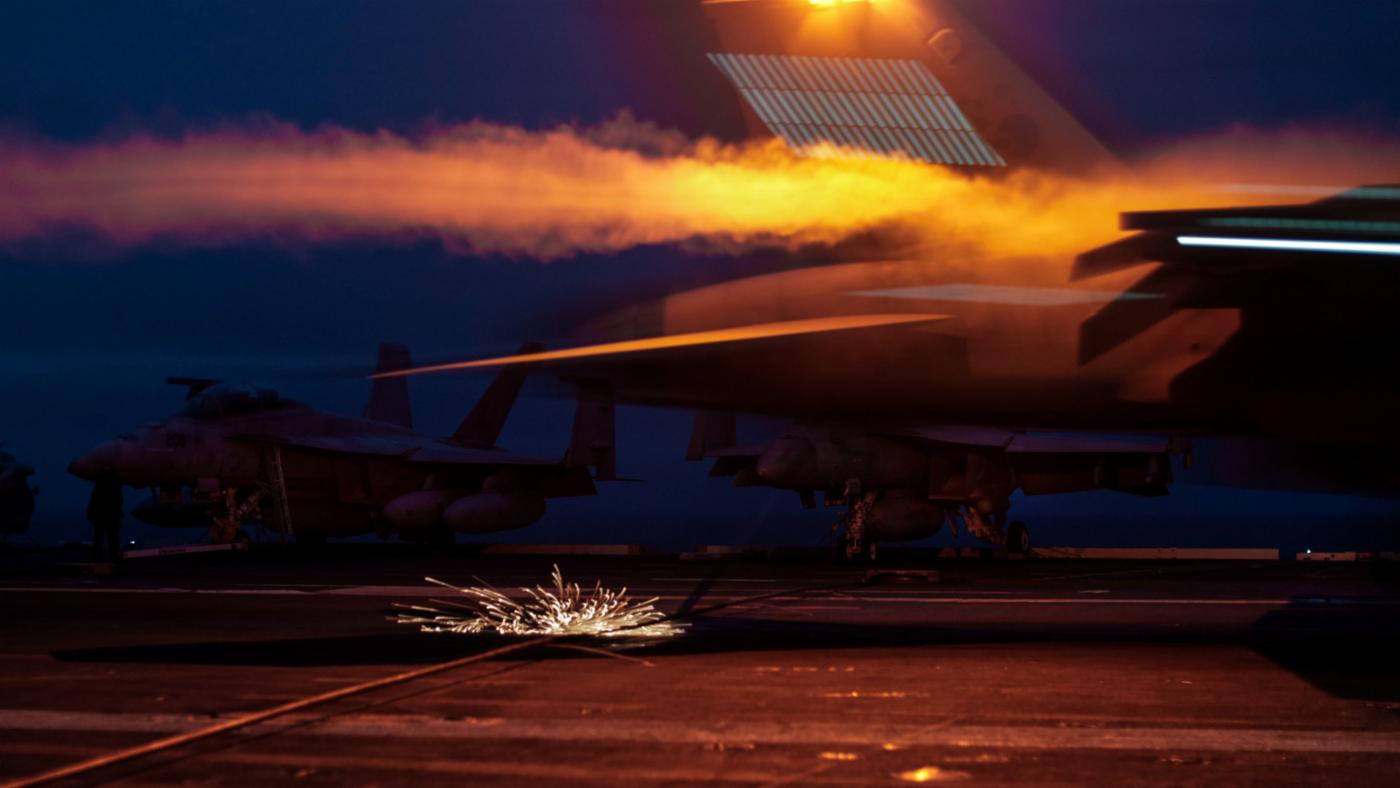
Sparks fly as the tail hook of a US Navy F/A-18 Super Hornet catches an arresting wire on the flight deck of the USS Gerald R. Ford.
Flight operations continue day and night. At the end of the day, the Landing Signal Officers enter the Bulls’ ready room to applause. “Yeah, Paddles!” the aviators shout, clapping and whistling.
When I ask Phil about the rapturous reception, he shrugs. “It’s mostly tradition,” he says. “But you have to remember, these guys are back there telling us how not to crash when we’re landing. They’re literally saving our lives.”
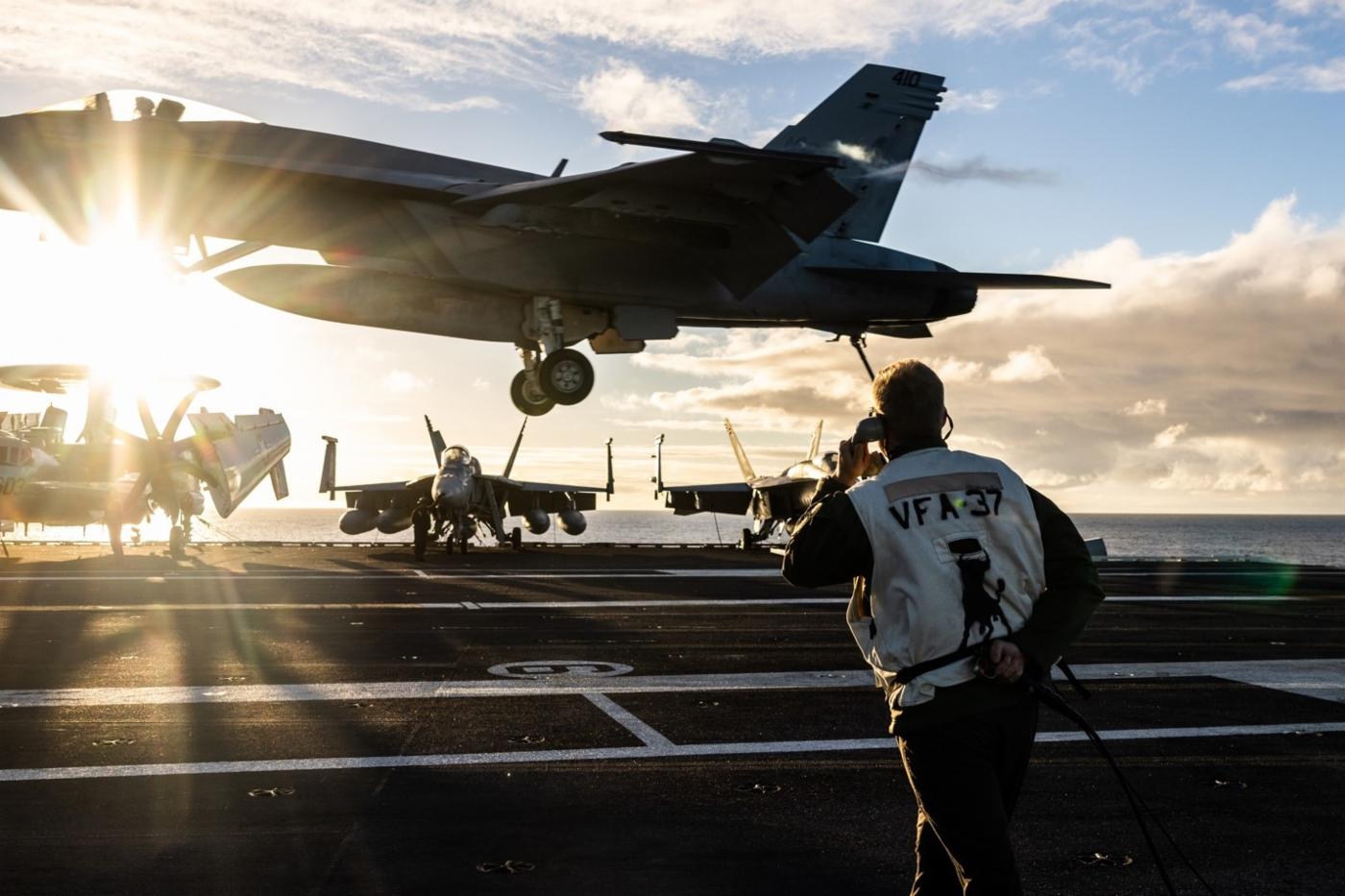
Lieutenant Commander William Craven, Landing Signal Officer for Naval Strike Fighter Squadron 37, guides an F/A-18E Super Hornet in for landing on the USS Gerald R. Ford.
On the last day of Silent Wolverine, Phil takes off for his last carrier landing. As a farewell courtesy, departing aviators are typically granted a low, fast pass by the carrier prior to landing.
I’m standing on a catwalk above the flight deck, camera in hand. The last sliver of sun is sinking into the sea, and here he comes, a black spot on the horizon, moving fast. As he nears the ship, he yanks the Super Hornet on its side and knifes through the air, flashing his belly at the boat, afterburners casting twin cones of fire from the engines. The roar thunders deep in my chest. He levels his wings at the ship’s stern and eases off the throttle so his jet seems to float towards the deck. His wings rock a little, but the approach is steady. When he lands, the tailhook throws up sparks as it catches the third arresting cable.
His squadron leader, Commander Pat “Who?” Bookey, is waiting for him in full flight gear, ready to take the jet on its next flight. Phil descends the ladder and Bookey gives him a half-hug, with a hearty backslap. It’s the only hint that something important just happened. There’s no speech, no medal, no certificate of appreciation – just a small gesture of thanks for a job well done. Phil strolls towards the edge of the ship – literally walking into the sunset, I think, trying not to roll my eyes – descends a flight of stairs and disappears into the hull.

